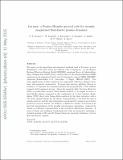| dc.contributor.author | Dorland, W. | |
| dc.contributor.author | Fazendeiro, L. | |
| dc.contributor.author | Kanekar, A. | |
| dc.contributor.author | Mallet, A. | |
| dc.contributor.author | Vilelas, M.S. | |
| dc.contributor.author | Zocco, A. | |
| dc.contributor.author | Gomes Loureiro, Nuno F | |
| dc.date.accessioned | 2018-10-09T19:15:09Z | |
| dc.date.available | 2018-10-09T19:15:09Z | |
| dc.date.issued | 2016-09 | |
| dc.date.submitted | 2016-04 | |
| dc.identifier.issn | 0010-4655 | |
| dc.identifier.uri | http://hdl.handle.net/1721.1/118403 | |
| dc.description.abstract | We report on the algorithms and numerical methods used in Viriato, a novel fluid–kinetic code that solves two distinct sets of equations: (i) the Kinetic Reduced Electron Heating Model (KREHM) equations (Zocco and Schekochihin, 2011) (which reduce to the standard Reduced-MHD equations in the appropriate limit) and (ii) the kinetic reduced MHD (KRMHD) equations (Schekochihin et al., 2009). Two main applications of these equations are magnetized (Alfvénic) plasma turbulence and magnetic reconnection. Viriato uses operator splitting (Strang or Godunov) to separate the dynamics parallel and perpendicular to the ambient magnetic field (assumed strong). Along the magnetic field, Viriato allows for either a second-order accurate MacCormack method or, for higher accuracy, a spectral-like scheme composed of the combination of a total variation diminishing (TVD) third order Runge–Kutta method for the time derivative with a 7th order upwind scheme for the fluxes. Perpendicular to the field Viriato is pseudo-spectral, and the time integration is performed by means of an iterative predictor–corrector scheme. In addition, a distinctive feature of Viriato is its spectral representation of the parallel velocity-space dependence, achieved by means of a Hermite representation of the perturbed distribution function. A series of linear and nonlinear benchmarks and tests are presented, including a detailed analysis of 2D and 3D Orszag–Tang-type decaying turbulence, both in fluid and kinetic regimes. Keywords: PlasmaFourier–Hermite, Reduced gyrokinetics, Turbulence, Magnetic reconnection | en_US |
| dc.description.sponsorship | Fundação para a Ciência e a Tecnologia (Portugal) (UID/FIS/50010/2013) | en_US |
| dc.description.sponsorship | Fundação para a Ciência e a Tecnologia (Portugal) (PTDC/FIS/118187/2010) | en_US |
| dc.description.sponsorship | Fundação para a Ciência e a Tecnologia (Portugal) (IF/00530/2013) | en_US |
| dc.description.sponsorship | Leverhulme Trust | en_US |
| dc.publisher | Elsevier BV | en_US |
| dc.relation.isversionof | http://dx.doi.org/10.1016/J.CPC.2016.05.004 | en_US |
| dc.rights | Creative Commons Attribution-NonCommercial-NoDerivs License | en_US |
| dc.rights.uri | http://creativecommons.org/licenses/by-nc-nd/4.0/ | en_US |
| dc.source | arXiv | en_US |
| dc.title | Viriato : A Fourier–Hermite spectral code for strongly magnetized fluid–kinetic plasma dynamics | en_US |
| dc.type | Article | en_US |
| dc.identifier.citation | Loureiro, N. F., et al. “Viriato : A Fourier–Hermite Spectral Code for Strongly Magnetized Fluid–Kinetic Plasma Dynamics.” Computer Physics Communications, vol. 206, Sept. 2016, pp. 45–63. | en_US |
| dc.contributor.department | Massachusetts Institute of Technology. Department of Nuclear Science and Engineering | en_US |
| dc.contributor.department | Massachusetts Institute of Technology. Plasma Science and Fusion Center | en_US |
| dc.contributor.mitauthor | Gomes Loureiro, Nuno F | |
| dc.relation.journal | Computer Physics Communications | en_US |
| dc.eprint.version | Original manuscript | en_US |
| dc.type.uri | http://purl.org/eprint/type/JournalArticle | en_US |
| eprint.status | http://purl.org/eprint/status/NonPeerReviewed | en_US |
| dc.date.updated | 2018-09-25T18:01:34Z | |
| dspace.orderedauthors | Loureiro, N.F.; Dorland, W.; Fazendeiro, L.; Kanekar, A.; Mallet, A.; Vilelas, M.S.; Zocco, A. | en_US |
| dspace.embargo.terms | N | en_US |
| dc.identifier.orcid | https://orcid.org/0000-0001-9755-6563 | |
| mit.license | PUBLISHER_CC | en_US |
